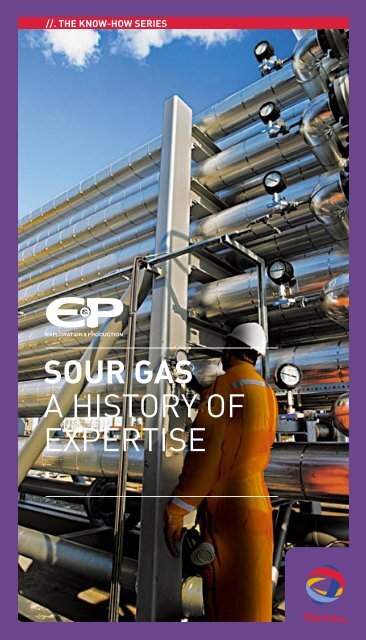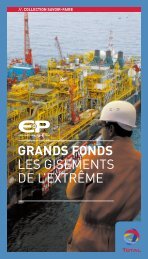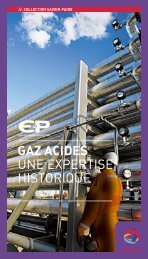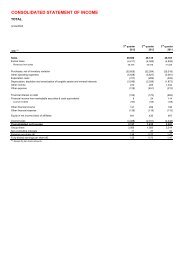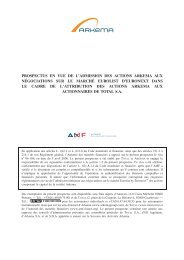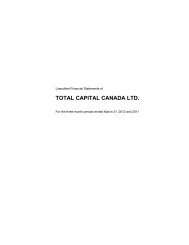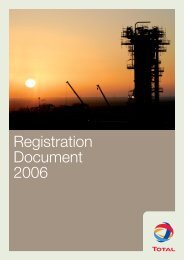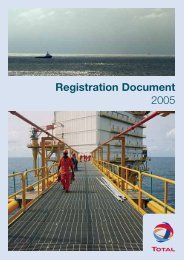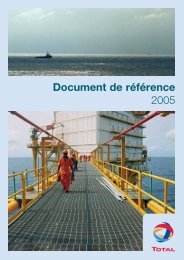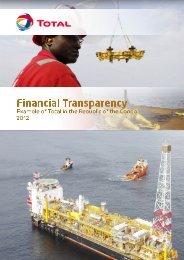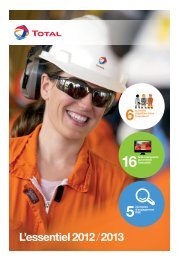Sour gas - A history of expertise - Total.com
Sour gas - A history of expertise - Total.com
Sour gas - A history of expertise - Total.com
You also want an ePaper? Increase the reach of your titles
YUMPU automatically turns print PDFs into web optimized ePapers that Google loves.
. the Know-how series<br />
ExPLOrATiOn & PrOducTiOn<br />
soUr GAs<br />
A <strong>history</strong> <strong>of</strong><br />
ExpErtisE
. Contents<br />
soUr GAs<br />
A <strong>history</strong><br />
<strong>of</strong> ExpErtisE<br />
s s s<br />
page 3 foreword<br />
page 4 Context<br />
40% <strong>of</strong> the world’s untapped <strong>gas</strong> reserves<br />
hold sour <strong>gas</strong>.<br />
page 6 ChAllenGes<br />
since the lacq discovery, total has<br />
continuously improved its sour <strong>gas</strong><br />
development processes.<br />
page 8 <strong>expertise</strong><br />
After mdEA, sprex ® opens a new road<br />
to the monetization <strong>of</strong> ultra-sour <strong>gas</strong> reserves.<br />
p. 10 lacq: a world first<br />
p. 14 Continuous innovation<br />
p. 18 sustainable management<br />
<strong>of</strong> residual products<br />
p. 20 production safety<br />
page 22 GroUp<br />
total worldwide in 2006.<br />
middle East.
. foreword<br />
extendinG the life<br />
<strong>of</strong> hydrocArBon rEsourcEs<br />
<strong>Total</strong>’s Exploration & Production branch<br />
continually pushes oil and <strong>gas</strong> production<br />
to new limits. Drawing on the <strong>com</strong>plete<br />
integration <strong>of</strong> its multidisciplinary<br />
<strong>expertise</strong>, the Group has honed a<br />
capacity for innovation that has secured<br />
its rank among the frontrunners in the<br />
technologies strategic to the future<br />
<strong>of</strong> the energy industry.<br />
<strong>Total</strong>’s Exploration & Production branch<br />
is involved in all <strong>of</strong> the industry’s key<br />
technological challenges, namely,<br />
extra-heavy crude oil, ultra-deepwater<br />
<strong>of</strong>fshore, sour <strong>gas</strong>, hydrocarbon<br />
resources that are deeply buried (highpressure/high-temperature)<br />
or difficult to<br />
produce because they are in “tight sand”<br />
reservoirs. At the same time, the Group<br />
“Innovation will be the main<br />
driver <strong>of</strong> sustainable growth<br />
in our production.”<br />
is inventing the tools and techniques<br />
required to access residual reserves<br />
on conventional acreage.<br />
Relying on synergies with other<br />
Group branches operating in the fields<br />
<strong>of</strong> <strong>gas</strong> and power, refining and marketing<br />
and petrochemicals, the E&P branch<br />
proposes technological solutions<br />
that cover the <strong>com</strong>plete value chain<br />
from production to finished products<br />
and/or markets.
04<br />
SOUR GAS<br />
s<br />
1. Doha, Qatar.<br />
What is<br />
sour <strong>gas</strong>?<br />
<strong>Sour</strong> <strong>gas</strong> is natural <strong>gas</strong> that<br />
contains not only methane and<br />
some long-chain hydrocarbons,<br />
but also H2S and/or CO2.<br />
Mercaptans, organic sulfur<br />
<strong>com</strong>pounds in the form R–S–H,<br />
are usually also present. The<br />
tubing, pipes and pumps for<br />
sour <strong>gas</strong> must be made <strong>of</strong> special<br />
metal, since H2S, CO2, and<br />
mercaptans are corrosive. These<br />
<strong>com</strong>pounds must be removed<br />
before the <strong>gas</strong> can be sold.<br />
//. Context<br />
Billions <strong>of</strong> cuBic mEtErs<br />
<strong>of</strong> GAs wAitinG<br />
to be tApped<br />
s s s<br />
Nearly 40% <strong>of</strong> the world’s <strong>gas</strong> reserves contain levels <strong>of</strong><br />
carbon dioxide (CO2) and hydrogen sulfide (H2S) that pose<br />
obstacles to development. Over<strong>com</strong>ing those obstacles is<br />
a key challenge for oil <strong>com</strong>panies.<br />
World demand for <strong>gas</strong> has risen at a rate <strong>of</strong> nearly 3% per year for the<br />
past thirty years, making natural <strong>gas</strong> the fossil energy with the strongest<br />
growth. The share <strong>of</strong> <strong>gas</strong> in global energy supply expanded from<br />
16% in 1971 to 21% in 2004, and the International Energy Agency<br />
forecasts continuing growth, to reach a share <strong>of</strong> 23% by 2030. In absolute<br />
value, <strong>gas</strong> consumption is thus expected to increase considerably<br />
from 2,800 to 4,700 billion cubic meters between 2004 and 2030.<br />
This strong development is driven above all by the environmental<br />
qualities <strong>of</strong> natural <strong>gas</strong>. It is a clean-burning fuel that leaves no<br />
heavy residues such as soot or tar, and releases the lowest carbon<br />
dioxide emissions <strong>of</strong> all the fossil fuels. Natural <strong>gas</strong> is also used to an<br />
increasing extent in power generation, where it <strong>of</strong>fers the additional<br />
advantage <strong>of</strong> allowing very high efficiency in both cogeneration and<br />
<strong>com</strong>bined-cycle units.<br />
Reserves <strong>of</strong> natural <strong>gas</strong> are abundant, totaling some 180,000 billion<br />
cubic meters worldwide. However, nearly 40% <strong>of</strong> the fields lying<br />
untapped contain concentrations <strong>of</strong> carbon dioxide (CO2) and hydrogen<br />
sulfide (H2S) that pose obstacles to their development. Such sour <strong>gas</strong><br />
fields are found in Europe, Africa, North and South America and<br />
the Far East, but the Middle East and Central Asia hold the largest<br />
volumes. <strong>Total</strong> became a world pioneer in sour <strong>gas</strong> production with<br />
its groundbreaking Lacq <strong>gas</strong> field development, in France.<br />
Since then, the Company has built on its <strong>expertise</strong> and innovated<br />
with techniques to enable the economically viable production<br />
<strong>of</strong> these unconventional resources, in <strong>com</strong>pliance with increasingly<br />
tough sales <strong>gas</strong> specifications and environmental objectives. nnn
06<br />
SOUR GAS<br />
s<br />
Lacq lights the way<br />
<strong>Total</strong> has many years <strong>of</strong><br />
experience in producing<br />
and sweetening sour <strong>gas</strong>.<br />
Two major milestones have<br />
been the Lacq field in France<br />
and the Ram River project<br />
in Alberta, Canada. The aminebased<br />
processes developed<br />
by <strong>Total</strong> for separating<br />
sour <strong>gas</strong> still rank among<br />
the most efficient solutions<br />
currently available.<br />
//. ChAllenGes<br />
A <strong>history</strong><br />
<strong>of</strong> ExpErtisE<br />
s s s<br />
Faced with the new challenges <strong>of</strong> the Lacq <strong>gas</strong><br />
field, <strong>Total</strong> invented many production and processing<br />
techniques for sour <strong>gas</strong> that are now used around<br />
the world.<br />
In the 1950s, with the development <strong>of</strong> the vast Lacq <strong>gas</strong> field in France,<br />
<strong>Total</strong> marked a world first by successfully upgrading a very sour <strong>gas</strong><br />
(16% H2S and 10% CO2) in high temperature and pressure conditions.<br />
To cope with the corrosive fluids and sulfur deposits, the Group<br />
developed techniques and materials to treat this aggressive <strong>gas</strong><br />
efficiently and safely. This strong base <strong>of</strong> know-how has continuously<br />
evolved; <strong>Total</strong>’s technology has made its way around the world to permit<br />
the successful development <strong>of</strong> more than sixty sour <strong>gas</strong> fields. Flagship<br />
projects include Elgin/Franklin (United Kingdom), South Pars and<br />
Dorood (Iran), Bongkot (Thailand), Kharyaga (Russia), Sleipner (Norway),<br />
and very sour <strong>gas</strong> reserves in Abu Dhabi. At present, <strong>Total</strong> is once again<br />
pushing back frontiers with cost-effective production methods for<br />
ultra-sour <strong>gas</strong> (over 20% <strong>of</strong> CO2 or H2S) and future-looking sweetening<br />
processes in preparation for increasingly stringent specifications.<br />
In the Group’s hydrocarbon production, the share <strong>of</strong> <strong>gas</strong> should reach<br />
35% by 2010.<br />
While the cost-effectiveness <strong>of</strong> technological solutions is a crucial<br />
factor for the future <strong>of</strong> sour <strong>gas</strong> development, safety for people and the<br />
environment is an equally requisite dimension. The Group’s <strong>com</strong>mitment<br />
to minimize the environmental impact <strong>of</strong> its operations is supported<br />
by major research activities. For sour <strong>gas</strong>, the focus is on improving<br />
the energy efficiency <strong>of</strong> sweetening processes, but the teams are also<br />
working on breakthrough technologies like the Sprex ® (for “Simple<br />
PRe-Extraction”) process. Currently in the pre-industrial phase, this<br />
process leads to significant savings in both the energy requirements and<br />
the cost <strong>of</strong> treating <strong>gas</strong>. In line with its <strong>com</strong>prehensive approach, <strong>Total</strong><br />
also studies solutions for the management as well as the marketing<br />
<strong>of</strong> sulfur streams and other by-products <strong>of</strong> the process. For the longer<br />
term, additional research programs are under way to explore options for<br />
the reinjection and storage <strong>of</strong> the acid fractions from these <strong>gas</strong>es. nnn
<strong>Total</strong>’s presence in the field <strong>of</strong> sour <strong>gas</strong><br />
1 2 3<br />
1. Bongkot South, Thailand.<br />
2. Elgin/Franklin, United Kingdom.<br />
3. Kharyaga, Russia.<br />
07
. <strong>expertise</strong><br />
A pioneer<br />
in thE fiEld<br />
<strong>of</strong> sour gAs<br />
s s s<br />
total discovered the lacq <strong>gas</strong> field in southwestern<br />
france in 1951. Given the high h2s and Co2<br />
concentrations <strong>of</strong> this <strong>gas</strong>, producing and processing<br />
the reserves meant a totally new challenge. less than<br />
seven years later, the feat was ac<strong>com</strong>plished – total had<br />
found solutions for the aggressive properties <strong>of</strong> these<br />
streams and could deliver a high-quality sales <strong>gas</strong>.<br />
the momentum <strong>of</strong> innovation sustained constantly<br />
since that time has driven the Group’s technological<br />
leadership for more than sixty years, with the<br />
development <strong>of</strong> solutions that <strong>com</strong>bine sound economics<br />
with respect for the environment.
10<br />
SOUR GAS<br />
s<br />
Lacq: Vital statistics<br />
Reservoir<br />
Depth: 3,500 m<br />
on average<br />
Pressure: about<br />
650 bar on discovery, 24 bar<br />
today<br />
Bottomhole temperature:<br />
140°C<br />
Gas <strong>com</strong>position<br />
Hydrocarbons: 74.2%<br />
Methane: 69%<br />
Ethane: 3%<br />
Propane: 0.9%<br />
Butane: 0.5%<br />
Pentane: 0.2%<br />
Hexane and other: 0.6%<br />
Acid <strong>gas</strong>es: 24.8%<br />
Hydrogen sulfide: 15.3%<br />
Mercaptans: 0.2%<br />
Carbon dioxide: 9.3%<br />
Water: 1%<br />
//. <strong>expertise</strong><br />
lAcQ:<br />
A world first<br />
s s s<br />
It took <strong>Total</strong> a mere few years to develop efficient<br />
techniques, notably amine-based sweetening processes,<br />
to address the challenges <strong>of</strong> a high-pressure,<br />
high-temperature sour <strong>gas</strong> reservoir. The Company’s<br />
solutions are now used around the world.<br />
<strong>Total</strong>’s first experience with sour <strong>gas</strong> began in 1951. During an exploration<br />
campaign for oil in southwestern France, the Lacq 3 well revealed a<br />
significant oil reservoir. The major quantities <strong>of</strong> hydrocarbons were found at<br />
a depth <strong>of</strong> 3,450 meters — but in <strong>gas</strong>eous form. The pressure here was so<br />
high that a great geyser <strong>of</strong> <strong>gas</strong> shot up through the borehole on<br />
December 19, 1951: <strong>Total</strong>’s historic introduction to the Lacq <strong>gas</strong> giant.<br />
650 bAr <strong>of</strong> pressUre<br />
Shooting out at a pressure <strong>of</strong> 530 to 670 bar and a temperature <strong>of</strong> 140°C,<br />
the <strong>gas</strong> initially had to be flared. It took two months to withdraw<br />
Millions <strong>of</strong> cu.m/d <strong>of</strong> raw <strong>gas</strong><br />
“first <strong>gas</strong>” 1957<br />
full capacity reached.<br />
downtime due mainly<br />
to regulatory inspection<br />
Reservoir<br />
650 bar<br />
Record recovery<br />
Since 1957 and the start <strong>of</strong> Lacq <strong>gas</strong><br />
production, 246 billion cubic meters<br />
<strong>of</strong> <strong>gas</strong> have been recovered here.<br />
Pressure inside the reservoir has<br />
dropped from 650 to 24 bar.<br />
A great number <strong>of</strong> seismic surveys<br />
and studies were carried out<br />
to model the reservoir in 3D,<br />
shutdown <strong>of</strong> three sulfur<br />
recovery units<br />
genuine decline<br />
in well potential<br />
Reservoir<br />
24 bar<br />
Cumulative <strong>gas</strong> production in billions <strong>of</strong> cu.m<br />
paving the way to a more detailed<br />
understanding <strong>of</strong> reservoir geometry<br />
for optimized siting <strong>of</strong> production<br />
wells. The result: proven recovery<br />
<strong>of</strong> 94%. Lacq has thus also enriched<br />
<strong>Total</strong>’s experience in the production<br />
<strong>of</strong> substantially depleted mature<br />
reservoirs.
1<br />
2<br />
Processing <strong>of</strong> hydrocarbons from the Lacq field<br />
raw <strong>gas</strong><br />
desulfurization sulfur recovery unit<br />
sweet<br />
<strong>gas</strong><br />
Condensate<br />
removal<br />
lacq crude oil stabilization<br />
thiochemicals<br />
ethane<br />
steam cracker<br />
sulfur<br />
thio<br />
products<br />
<strong>com</strong>mercial <strong>gas</strong><br />
lpg<br />
(butane, propane)<br />
Ethylene<br />
light hydrocarbons<br />
condensates<br />
petroleum products<br />
the drilling assembly and plug the well. When the drill string was pulled<br />
out, the engineers discovered an unusual phenomenon – the <strong>gas</strong> had<br />
altered the molecular <strong>com</strong>position <strong>of</strong> the steel and caused cracking in<br />
all the welded parts.<br />
sUlfide Corrosion CrACKinG<br />
The explanation for this phenomenon lies in the <strong>com</strong>position <strong>of</strong> sour<br />
<strong>gas</strong>. Containing 10% carbon dioxide (CO2) and 16% hydrogen sulfide<br />
(H2S), as in the case <strong>of</strong> Lacq, the <strong>gas</strong> causes “sulfide corrosion<br />
cracking.” No one at the time knew how to produce sour <strong>gas</strong> with very<br />
high levels <strong>of</strong> sulfur, and experts considered the Lacq discovery a<br />
“write-<strong>of</strong>f.” That was no deterrent for <strong>Total</strong>. The Group set out fully<br />
determined to develop the field, which promised to be a major discovery<br />
(over 240 billion cubic meters).<br />
Two wells were drilled to appraise the size <strong>of</strong> the reservoir – one<br />
1,500 m north <strong>of</strong> the initial well, the other 1,500 m to the south.<br />
Both encountered <strong>gas</strong>, as recorded in 1953. A major research effort<br />
then got under way to define the materials and processes needed<br />
to develop the <strong>gas</strong>. In 1955, after two years <strong>of</strong> work, the Pompey<br />
steelworks presented a type <strong>of</strong> steel that was resistant to H2S.<br />
1. Aerial view <strong>of</strong> the Lacq <strong>com</strong>plex,<br />
France.<br />
11<br />
2. <strong>Total</strong> has developed a control<br />
system that adjusts the activity<br />
<strong>of</strong> reagents in real time to guarantee<br />
specified <strong>com</strong>position <strong>of</strong> the<br />
treated <strong>gas</strong>.
12<br />
SOUR GAS<br />
s<br />
Ram River,<br />
35% H2S<br />
In 1961, capitalizing on the<br />
experience gained at Lacq,<br />
<strong>Total</strong> first exported its knowhow<br />
to the Pincher Creek field<br />
in Alberta, Canada. In 1972,<br />
the Company rose to a new<br />
challenge by producing the<br />
<strong>gas</strong> from Alberta’s Ram River<br />
field. H2S content: 35%! By<br />
successfully sweetening this <strong>gas</strong><br />
with an amine technology, <strong>Total</strong><br />
set yet another international<br />
precedent, demonstrating that<br />
its solutions can be effectively<br />
applied to the development<br />
<strong>of</strong> ultra-sour <strong>gas</strong> resources.<br />
//. <strong>expertise</strong><br />
pp<br />
Parallel research culminated in the choice and optimization<br />
<strong>of</strong> amine-based processes (see page 14), the chemical key to the <strong>gas</strong><br />
sweetening process. <strong>Total</strong> also worked on the sulfur recovery aspects,<br />
and developed Claus-type processes enabling liquid sulfur production<br />
with energy recovery. The construction <strong>of</strong> the <strong>gas</strong> processing plant got<br />
under way at the end <strong>of</strong> 1955, while appraisal <strong>of</strong> the field continued.<br />
In all, 34 wells were drilled: 32 turned out to be producers.<br />
A GAs GiAnt<br />
The first production phase began in April 1957, with a processing and<br />
production capacity <strong>of</strong> 1 million cubic meters per day. It included<br />
desulfurization, condensate removal, the recovery <strong>of</strong> sulfur from<br />
the H2S, and the refining <strong>of</strong> the by-products. This phase yielded streams<br />
<strong>of</strong> purified <strong>gas</strong> along with hydrocarbons that are used by the chemical<br />
industry — ethane, propane, butane — and sulfur. Three additional<br />
phases were <strong>com</strong>missioned in July 1958, May 1959, and 1960,<br />
boosting processing capacity to more than 20 million cubic meters<br />
<strong>of</strong> <strong>gas</strong> per day, with an unflinching emphasis on the highest standards<br />
<strong>of</strong> industrial safety.<br />
Through <strong>Total</strong>’s determination and efforts, Lacq grew into a world-class<br />
<strong>com</strong>plex. The sulfur from Lacq accounted for 100% <strong>of</strong> French output,<br />
and 8.5% <strong>of</strong> world supply. In 1960, the field produced 90% <strong>of</strong> the <strong>gas</strong><br />
consumed in France. The <strong>com</strong>plex began to take shape as a hub<br />
<strong>of</strong> industry, with a power plant, an aluminum plant, and various plants<br />
manufacturing methanol, fertilizers and vinyl chloride, all <strong>of</strong> which<br />
made use <strong>of</strong> residual <strong>gas</strong> from the Lacq operations. At its plateau<br />
production level in the 1970s, the site was producing 33 million cubic<br />
meters <strong>of</strong> <strong>gas</strong> a day.<br />
tUrninG A ConstrAint into A leAdinG edGe<br />
Although Lacq’s <strong>gas</strong> production is currently on the decline, the<br />
momentum set <strong>of</strong>f by this field is stronger than ever. Developing<br />
ever-more efficient sweetening and recovery processes (see page 14),<br />
the Group has also exported its know-how internationally, as operator<br />
or through licensing. Around the world, more than 60 sour <strong>gas</strong> fields<br />
— including Elgin/Franklin (United Kingdom), South Pars<br />
and Dorood (Iran), Sleipner (Norway), and very sour <strong>gas</strong> reserves<br />
in Abu Dhabi — are now being produced using <strong>Total</strong> processes.<br />
Starting with the Lacq field, <strong>Total</strong> has turned a geological constraint<br />
into a technological advantage. nnn
Elgin/Franklin, the challenge <strong>of</strong> variable <strong>com</strong>position<br />
Combining record depths with<br />
record pressures and temperatures<br />
(5,500 m burial depth, 1,100 bar<br />
and 190°C), the highly innovative<br />
tandem development <strong>of</strong> the Elgin<br />
and Franklin fields also constitutes<br />
an exceptional performance<br />
in sour <strong>gas</strong> treating. The two<br />
reservoirs in the central part <strong>of</strong> the<br />
UK sector <strong>of</strong> the North Sea hold<br />
vast reserves <strong>of</strong> <strong>gas</strong> condensate. The<br />
<strong>com</strong>position <strong>of</strong> the <strong>gas</strong> is not quite<br />
the same in the two reservoirs<br />
– the CO2 content varies between<br />
2.4 and 4%, while the H2S content<br />
can range up to 50 ppm. <strong>Total</strong> has<br />
succeeded in using a single<br />
sweetening unit designed to treat<br />
the mix from these two sources,<br />
which is a <strong>gas</strong> with variable<br />
<strong>com</strong>position.<br />
Using amine technology (activated<br />
MDEA), the sweetening unit<br />
directly delivers a <strong>gas</strong> that meets<br />
export-sales specifications, with<br />
1.5% ± 0.2% CO2 and less than<br />
1 ppm H2S. To absorb the H2S,<br />
the chosen option is moderately<br />
activated MDEA, which allows<br />
simultaneous, controlled<br />
absorption <strong>of</strong> the CO2 at a rate<br />
that varies with the CO2 content<br />
<strong>of</strong> the stream. The concentration<br />
<strong>of</strong> CO2 in the raw stream and<br />
in the treated <strong>gas</strong> is very precisely<br />
monitored and the operating<br />
parameters <strong>of</strong> the unit are adjusted<br />
accordingly, using a mass transfer<br />
model developed by <strong>Total</strong>.<br />
Guaranteeing a <strong>gas</strong> output in full<br />
<strong>com</strong>pliance with export-sales<br />
specifications regardless <strong>of</strong> the<br />
inlet <strong>com</strong>position <strong>of</strong> the stream,<br />
this installation will accept flow<br />
rate variations <strong>of</strong> up to 70%,<br />
meaning there is no need for<br />
flaring when changes in flow rates<br />
and/or <strong>com</strong>position occur.<br />
Simplified process<br />
flow diagram.
14<br />
SOUR GAS<br />
s<br />
South Pars<br />
The South Pars <strong>gas</strong> field in Iran<br />
holds slightly sour <strong>gas</strong>: 2% CO2<br />
and 0.54% H2S. Since<br />
March 2002, this field has been<br />
delivering high-quality <strong>gas</strong> into<br />
Iran’s sales network. To avoid<br />
hydrate formation and control<br />
corrosion in the multiphase<br />
pipelines that transport the <strong>gas</strong><br />
105 km to shore, a solution <strong>of</strong><br />
mono-ethylene glycol with<br />
MDEA-controlled pH is injected<br />
at the production point. The<br />
selective sweetening process is<br />
carried out onshore, using<br />
MDEA. From start-up until now,<br />
the treated <strong>gas</strong> output has<br />
exceeded the original project<br />
objectives by 10 to 15%.<br />
//. <strong>expertise</strong><br />
continuous<br />
innovAtion<br />
s s s<br />
Taking advantage <strong>of</strong> steady progress in the field <strong>of</strong><br />
amines, <strong>Total</strong> has developed efficient and cost-effective<br />
solutions for sour <strong>gas</strong> processing. The success story<br />
<strong>of</strong> innovation is now continuing with the conquest<br />
<strong>of</strong> ultra-sour <strong>gas</strong> fields, notably via optimized amines<br />
and the new Sprex ® process.<br />
Ever since the first studies for the Lacq <strong>gas</strong> field in the 1950s, <strong>Total</strong><br />
has steadily improved its amine-based sweetening processes to hone<br />
their efficiency and expand their scope <strong>of</strong> application. These intensive<br />
and sustained R&D efforts have produced a rich and diversified palette<br />
<strong>of</strong> solutions for all types <strong>of</strong> sour <strong>gas</strong> streams, consolidating <strong>Total</strong>’s<br />
leadership through the years.<br />
severAl GenerAtions <strong>of</strong> Amines<br />
In 1957, <strong>Total</strong>’s first sour <strong>gas</strong> sweetening unit went into operation.<br />
It was designed to treat 1 million cubic meters <strong>of</strong> <strong>gas</strong> per day, using a<br />
process based on diethanolamine (DEA). In contact with the raw <strong>gas</strong>, the<br />
“lean” diethanolamine rapidly reacts with the H2S and CO2, stripping out<br />
the acid <strong>com</strong>pounds. The “loaded” amine is regenerated in a reboiler<br />
and then used again. This process was improved over the years to<br />
reduce costs and energy consumption, and boost sweetening efficiency.<br />
In 1978, <strong>Total</strong> achieved another technological milestone that opened<br />
the era <strong>of</strong> selective sweetening using methyl diethanolamine (MDEA).<br />
This process was applied for the first time at the Chémery unit,<br />
then integrated into several Lacq units in 1980. MDEA has slow CO2<br />
absorption kinetics. It thus captures significant amounts <strong>of</strong> H2S only,<br />
with practically no change in CO2 levels. This property makes MDEA<br />
a very attractive candidate for some North Sea and Middle East fields.<br />
In addition, its regeneration requires less energy than for DEA, adding up<br />
to substantial savings in the <strong>gas</strong> treating cycle.<br />
In 1990, the studies conducted by the Group paved the way for another<br />
major step: <strong>Total</strong> extended its portfolio with a process for “made-tomeasure”<br />
sweetening. In this new-generation process, first used on<br />
the Lacq <strong>gas</strong> field, the MDEA is activated using a secondary amine that<br />
accelerates the reaction <strong>of</strong> the CO2 with the aqueous solvent. The speed<br />
<strong>of</strong> reaction is modulated by using different types <strong>of</strong> activators, in different<br />
concentrations. The process thus allows either <strong>com</strong>plete or specifically<br />
controlled removal <strong>of</strong> CO2 (see process flow diagram, page 15).<br />
These technological achievements have met with <strong>com</strong>mercial success<br />
worldwide. Robust, reliable and efficient, the processes have found<br />
numerous international applications: as early as 1961 for DEA, and since<br />
1987 and 1996 for MDEA and activated MDEA respectively. Between<br />
1957 and 2005, some 70 projects in Canada, India, Iran, Nigeria, Norway,
Qatar, Russia, the United Kingdom and elsewhere chose <strong>Total</strong>’s amine<br />
technologies to treat their raw sour <strong>gas</strong>, either entrusting the operations<br />
to the Group or applying <strong>Total</strong>’s technologies under license.<br />
hybrid solvent teChnoloGy<br />
The R&D teams at <strong>Total</strong> are now working on new projects for amines<br />
<strong>of</strong>fering optimized technological and economic performance. Particular<br />
attention is being focused on hybrid solvents (i.e., adding a physical<br />
solvent to the amine, a chemical solvent) and on mixtures <strong>of</strong> different<br />
chemical solvents. These processes are more effective at separating<br />
organic sulfur <strong>com</strong>pounds (mercaptans), COS and CS2, and solvent<br />
regeneration requires less energy. In addition, regeneration can be<br />
carried out under pressure – a major advantage in light <strong>of</strong> new production<br />
scenarios based on the re-injection <strong>of</strong> <strong>com</strong>pressed acid <strong>gas</strong>es<br />
into geological reservoirs, which may or may not be depleted.<br />
Hybrid solvent processes would fit perfectly into such a residual acid<br />
<strong>gas</strong> injection chain, improving processing performance while reducing<br />
overall energy consumption.<br />
These solutions are also promising for the removal <strong>of</strong> mercaptans from<br />
sour <strong>gas</strong>, which at present requires large amounts <strong>of</strong> solvent.<br />
• DEA : diethanolamine (HN –<br />
(CH2-CH2-OH)2), a secondary<br />
amine. The first generation<br />
<strong>of</strong> solvents used by the Group.<br />
• MDEA : methyl diethanolamine<br />
(H3C–N (CH2–CH2–OH)2),<br />
a tertiary amine. This second<br />
generation <strong>of</strong> amines was<br />
pp<br />
<strong>Total</strong> amine processes: a <strong>history</strong> <strong>of</strong> progress<br />
developed by <strong>Total</strong>’s R&D teams.<br />
• Activated MDEA : in this latest<br />
generation process first used on<br />
the Lacq <strong>gas</strong> field in 1990, the<br />
MDEA is activated with a<br />
secondary amine that accelerates<br />
the reaction <strong>of</strong> the CO2 with<br />
the aqueous solvent. The speed<br />
On Elgin / Franklin, sour <strong>gas</strong> is<br />
sweetened by contact with the amine<br />
solution in an absorption column.<br />
<strong>of</strong> reaction can be modulated<br />
by the choice <strong>of</strong> the activator.<br />
This process thus permits either<br />
<strong>com</strong>plex or controlled removal<br />
<strong>of</strong> CO2, for “made-to-measure”<br />
sweetening solutions.<br />
15
16<br />
SOUR GAS<br />
s<br />
Extending<br />
Sprex ® to CO2<br />
The Sprex ® process was initially<br />
developed to separate H2S. An<br />
improved version is now ready<br />
for the treating <strong>of</strong> <strong>gas</strong> with high<br />
CO2 levels. In this process, named<br />
Sprex ® CO2, a temperature <strong>of</strong><br />
about -60° to -70°C must be<br />
attained, depending on the target<br />
specification. That requires<br />
preliminary dehydration <strong>of</strong> the<br />
<strong>gas</strong>, to avoid hydrate formation in<br />
the Sprex ® column. Sprex ® CO2<br />
is a cost-effective alternative to<br />
conventional processes based on<br />
solvents or semi-permeable<br />
membranes for treating <strong>gas</strong> with<br />
high CO2 concentrations.<br />
//. <strong>expertise</strong><br />
pp<br />
<strong>Total</strong> R & D systematically screens potential molecules and then<br />
tests the efficiency <strong>of</strong> each formulation using a pressure pilot at Lacq.<br />
This new type <strong>of</strong> process can supplement existing solutions to remove<br />
<strong>com</strong>pounds that resist the amines, thereby reducing overall energy<br />
consumption. With its mastery <strong>of</strong> the entire <strong>gas</strong> treating chain,<br />
<strong>Total</strong> is fully equipped to move rapidly from tests to an industrial solution.<br />
sprex ® , A teChnoloGiCAl breAKthroUGh<br />
Established technologies for sweetening raw sour <strong>gas</strong> are destined to<br />
evolve, however, given the limited size and the saturation <strong>of</strong> the market<br />
for sulfur reclaimed from the residual H2S. Moreover, environmental<br />
constraints now limit discharge <strong>of</strong> CO2 and SO2 to the atmosphere.<br />
For this new challenge, <strong>Total</strong> collaborated with the French Petroleum<br />
Institute, IFP, to develop a new process called Sprex ® primarily targeting<br />
fields in the Middle East that have not been produced for lack <strong>of</strong><br />
economically viable solutions. With Sprex ® , the scope <strong>of</strong> application<br />
<strong>of</strong> the more conventional amine-based chemical processes can be<br />
extended to <strong>gas</strong> with very high H2S concentrations.<br />
Sprex ® , short for “Simple PRe-Extraction”, is used early in the<br />
sweetening chain to separate H2S by cryogenic distillation. The acid <strong>gas</strong><br />
fraction is extracted in liquid form, at high pressure (50 to 70 bar).<br />
This liquid is rich in H2S and contains CO2, the heavier hydrocarbons,<br />
and water; it can easily be pumped into a geological reservoir.<br />
The pre-sweetened <strong>gas</strong> from the Sprex ® unit is then treated in a<br />
conventional amine unit <strong>of</strong> small size. Although the process requires two<br />
steps, this technology is less costly and especially less energy-intensive<br />
than equivalent treating using amine technology alone, essentially<br />
because <strong>of</strong> the savings on the <strong>com</strong>pression <strong>of</strong> the acid <strong>gas</strong>.<br />
Sprex ® operating principle<br />
> 20% H2S 10-12% H2S<br />
Raw sour <strong>gas</strong> sprex Pretreated <strong>gas</strong><br />
®<br />
Liquid H2S<br />
Residual acid <strong>gas</strong><br />
Re-injection<br />
Sales <strong>gas</strong><br />
Conventional<br />
treating<br />
(e.g., amine<br />
scrubbing)
Sprex ® process flow diagram<br />
Raw <strong>gas</strong> in<br />
Purified<br />
<strong>gas</strong> out<br />
Scrubber<br />
H2O<br />
Condenser<br />
Reflux<br />
(H2O<br />
rectif)<br />
Distillation<br />
60-70°C<br />
Reboiler<br />
(HC stripping)<br />
In the period from April 2005 to July 2006, the Sprex ® process was<br />
validated at the Lacq plant in a unit with a treating capacity <strong>of</strong><br />
70,000 cubic meters <strong>of</strong> raw <strong>gas</strong> per day. The feed stream was a<br />
water-saturated <strong>gas</strong> containing 18 to 40% H2S. The experience gained<br />
by running this industrial pilot has allowed <strong>Total</strong> to demonstrate<br />
the robust qualities <strong>of</strong> the Sprex ® process, which has now been fully<br />
integrated into the Group’s portfolio <strong>of</strong> sweetening solutions. nnn<br />
- 30°C<br />
Lowtemperature<br />
separation<br />
Liquid H2S<br />
License<br />
co-management<br />
with IFP<br />
17<br />
<strong>Total</strong> has entrusted the French<br />
Petroleum Institute (IFP)<br />
with the management and<br />
marketing <strong>of</strong> its <strong>gas</strong> sweetening<br />
processes. IFP’s wholly-owned<br />
subsidiary Prosernat designs<br />
the sweetening units.<br />
Sprex ® : the pilot unit at Lacq.
18<br />
SOUR GAS<br />
s<br />
GTL and CO2<br />
Produced CO2 can be<br />
economically reclaimed in a<br />
Gas-to-Liquids (GTL) conversion<br />
reaction. This option is being<br />
explored through research into<br />
the Fischer-Tropsch GTL process,<br />
which produces syn<strong>gas</strong> then<br />
converts it into liquid<br />
hydrocarbons. The presence <strong>of</strong><br />
CO2 in the feed<strong>gas</strong> for the syn<strong>gas</strong><br />
reactor improves the carbon<br />
efficiency <strong>of</strong> the GTL conversion.<br />
//. <strong>expertise</strong><br />
sUstAinAble<br />
mAnAGement<br />
<strong>of</strong> rEsiduAl products<br />
s s s<br />
<strong>Total</strong> is developing specific techniques to make<br />
the development <strong>of</strong> sour resources as safe as possible<br />
for the environment. Injection is an option that avoids<br />
sulfur production and reduces emissions <strong>of</strong> CO2.<br />
<strong>Sour</strong> <strong>gas</strong> processes generate emissions that have strong concentrations<br />
<strong>of</strong> H2S — a lethal <strong>gas</strong> in even minimal doses — and that may also contain<br />
CO2, entailing harmful effects on the environment. The safe and reliable<br />
management <strong>of</strong> these so-called residual <strong>gas</strong>es is a priority focus <strong>of</strong><br />
the Group’s Research & Development efforts.<br />
solUtions for sUlfUr<br />
H2S can be converted to sulfur using <strong>Total</strong> proprietary processes<br />
in Claus units. In the first phase, part <strong>of</strong> the H2S is converted to SO2<br />
in a thermal reaction: 2H2S + 3O2 ➝ 2SO2 + 2H2O. The SO2 is then<br />
contacted with the remaining part <strong>of</strong> H2S for a Claus reaction yielding<br />
sulfur: 2H2S + SO2 ➝ 3/2 S2 + 2H2O. With this option, sufficient energy<br />
to power the <strong>gas</strong> sweetening units can generally be recovered provided<br />
the H2S/CO2 ratio is high enough. The Group has also developed<br />
Sulfreen, selective amine and other processes for treating residual<br />
<strong>gas</strong>es from sulfur plants, and possesses know-how in the area <strong>of</strong><br />
sulfur conditioning systems, notably for de<strong>gas</strong>sing liquid sulfur with<br />
Aquisulf technology. In other words, <strong>Total</strong> can boast end-to-end<br />
mastery <strong>of</strong> the chain: production, handling, storage, and sale.<br />
The saturation <strong>of</strong> the sulfur market — a situation that is likely to last —<br />
is prompting the need for new solutions for the storage <strong>of</strong> sulfur or<br />
H2S. One option considered promising by many operators is injecting<br />
residual acid <strong>gas</strong>es directly into depleted reservoirs. This can be<br />
facilitated by using the Sprex ® process, as it enables the separation<br />
<strong>of</strong> H2S under high pressure. Implementing this solution requires<br />
<strong>com</strong>plete control <strong>of</strong> corrosion and all other aspects related to the<br />
extreme toxicity <strong>of</strong> H2S. The risks and uncertainties involved in storing<br />
H2S in geological reservoirs must also be fully mastered. This is one<br />
<strong>of</strong> the major challenges facing the Group as it pursues research in<br />
this extremely <strong>com</strong>plex field.<br />
Residual acid <strong>gas</strong>es can also be used to enhance oil recovery (EOR),<br />
but to avoid the risk <strong>of</strong> cycling these <strong>gas</strong>es into the producing wells,<br />
thorough knowledge <strong>of</strong> the reservoir and mastery <strong>of</strong> material-flow<br />
modeling are imperative.<br />
solUtions for Co2<br />
Although the residual CO2 from treating sour <strong>gas</strong> is less hazardous than<br />
the H2S, it nonetheless contributes to climate change. The Group’s<br />
objective is thus to release as little <strong>of</strong> it as possible into the atmosphere.<br />
<strong>Total</strong> is therefore studying options such as CO2 storage in depleted
The various types <strong>of</strong> geological storage<br />
<br />
<br />
<br />
<br />
<br />
<br />
<br />
<br />
<br />
<br />
<br />
<br />
<br />
<br />
<br />
1 co2 storage 2<br />
<br />
in 1 3 2 co2 4 1 storage 3 2 1 4 3<br />
co2 2<br />
storage 4 3 in an 4<br />
co2 <br />
storage in coalbeds with<br />
a depleted <strong>gas</strong> field. in a saline aquifer. oil field with Eor. enhanced methane recovery.<br />
reservoirs, deep saline aquifers, and coalbeds, but also the use <strong>of</strong> CO2 for<br />
enhanced oil recovery (EOR). In 2001, <strong>Total</strong> E&P teamed up with various<br />
research institutes and partners in academia and industry to undertake an<br />
R&D program dedicated to CO2 capture and storage. The program gives<br />
the Group a role in a number <strong>of</strong> national and international initiatives that<br />
draw on theoretical and experimental research, industrial pilot installations,<br />
and lessons learned from ongoing projects. For example, <strong>Total</strong> is a<br />
member <strong>of</strong> CO2 ReMoVe, a consortium uniting different industries and<br />
research organizations to foster the development <strong>of</strong> projects for the<br />
geological storage <strong>of</strong> CO2 in Europe and neighboring countries. The Group<br />
is also a member <strong>of</strong> the ENCAP (ENhanced CAPture) working group,<br />
coordinated by the Swedish energy concern and power producer,<br />
Vattenfall. ENCAP focuses on the development <strong>of</strong> CO2 capture processes<br />
for coal-, natural <strong>gas</strong>- and oil-fired power generation systems. The Group<br />
also supports Picoref (Piégeage du CO2 dans les Réservoirs en France)<br />
which is preparing industrial demonstrations <strong>of</strong> CO2 injection in France,<br />
notably in hydrocarbon reservoirs and salt aquifers around Paris. More<br />
concretely, <strong>Total</strong> is participating in the project on the Sleipner field,<br />
where CO2 has been injected into an aquifer since 1996. The Group is<br />
also a partner in the CO2 injection project in the Statoil-operated SnØhvit<br />
field (Berens Sea). In this project, the CO2 is extracted onshore in an<br />
LNG plant, then piped back out to sea and injected via subsea wells into<br />
the saline formations <strong>of</strong> the Tubåen sandstone, at a depth <strong>of</strong> 2,600 m.<br />
On Canada’s Weyburn oil field, <strong>Total</strong> is a partner in yet another R&D<br />
project centered on the first industrial-scale application <strong>of</strong> CO2 capture<br />
<strong>com</strong>bined with enhanced oil recovery.In 2005, the Group launched the<br />
study phase in preparation for the construction <strong>of</strong> a pilot oxyfuel<br />
<strong>com</strong>bustion installation for CO2 capture and storage in the depleted<br />
reservoir <strong>of</strong> the Lacq basin in France. nnn<br />
<br />
<br />
Crystallizing sulfur<br />
in the reservoir<br />
An alternative to geological<br />
storage <strong>of</strong> H2S is to produce<br />
solid sulfur not in surface<br />
facilities, but in depleted<br />
hydrocarbon reservoirs that<br />
contained H2S. This principle<br />
involves burning the H2S or<br />
sulfur to obtain SO2 that can be<br />
reinjected into the reservoir. In<br />
a Claus reaction, the contact <strong>of</strong><br />
this fluid with the native H2S<br />
in the reservoir would yield<br />
water and sulfur. If it proves<br />
feasible, this method will <strong>of</strong>fer<br />
the advantage <strong>of</strong> a long-term<br />
solution to the problem posed<br />
by H2S, since solid sulfur is<br />
perfectly stable. This option<br />
could thus be applied in<br />
appropriate depleted reservoirs<br />
near producing sour <strong>gas</strong> fields.<br />
<br />
19
20<br />
SOUR GAS<br />
s<br />
Gas detectors.<br />
//. <strong>expertise</strong><br />
prodUCtion<br />
sAfEty<br />
s s s<br />
Toxic, corrosive and sometimes flammable, sour <strong>gas</strong> raises<br />
critical production safety issues. Using purpose-designed<br />
materials, dense arrays <strong>of</strong> sensors and leading-edge risk<br />
modeling, <strong>Total</strong> can produce these challenging resources<br />
without <strong>com</strong>promising on safety.<br />
Ensuring the safety <strong>of</strong> facilities and operations is a core responsibility<br />
for an industrial player like <strong>Total</strong>. This imperative requires specific<br />
measures when producing and processing hazardous fluids such as<br />
sour and acid <strong>gas</strong>es.<br />
prevention And AntiCipAtion<br />
Two pillars <strong>of</strong> <strong>Total</strong>’s safety policy are risk assessment and anticipation,<br />
aimed at preventing accidents and minimizing the consequences<br />
<strong>of</strong> any that do occur. In practice, that translates into strict safety<br />
procedures, regular accident simulations and safety drills conducted<br />
at all <strong>Total</strong>-operated sites.<br />
Accident scenarios undergo quantitative risk analyses in which 2D and 3D<br />
tools are used to fine-tune simulations <strong>of</strong> pollutant dispersion patterns and<br />
delineate hazard zones. Research is also ongoing to improve dense-phase<br />
dynamic simulation models.<br />
A global challenge for the Group<br />
Worldwide, the Group has<br />
operations at more than 500 sites<br />
that fall within the scope <strong>of</strong><br />
the European Union’s Seveso<br />
Directive on establishments where<br />
dangerous substances are present. In<br />
this context, the policy pursued by<br />
<strong>Total</strong> is supported by assessments <strong>of</strong><br />
its safety management systems by<br />
independent and globally recognized<br />
auditors. By late 2006, over 70%<br />
<strong>of</strong> the Group’s worldwide facilities<br />
will have been assessed.<br />
In late 2004, <strong>Total</strong> also instituted<br />
a standard method for risk<br />
assessment to be applied across<br />
all <strong>of</strong> its global activities. This<br />
method is designed to harmonize<br />
the assessment criteria used in the<br />
different sectors <strong>of</strong> activity, and to<br />
provide more detailed data on the<br />
risks related to its facilities.<br />
Managing any potential crises or<br />
emergencies demands flawless<br />
coordination among all the entities<br />
involved, coupled with a capacity for<br />
prompt mobilization <strong>of</strong> a<br />
multidisciplinary network<br />
assembling the relevant skills and<br />
<strong>expertise</strong>. To ensure the solidity and<br />
responsiveness <strong>of</strong> its crisis<br />
management organization, <strong>Total</strong> has<br />
established three levels <strong>of</strong> response:<br />
the “Local level” (site or subsidiary)<br />
to manage the situation in the field;<br />
the “Branch level” to mobilize a<br />
multidisciplinary team; and the<br />
“Corporate level,” to take decisions<br />
beyond the immediate term and<br />
ensure the necessary oversight.
1 3<br />
Corrosion Control<br />
<strong>Total</strong> has implemented alloys specifically adapted to sour <strong>gas</strong> flows<br />
since the late 1950s, with the development <strong>of</strong> the Lacq field. The more<br />
aggressive fluids in as-yet undeveloped fields pose new challenges<br />
in terms <strong>of</strong> both tubing and pumps. For example, future development<br />
schemes call for the re-injection <strong>of</strong> the residual acid <strong>gas</strong>es — fluids<br />
with high concentrations <strong>of</strong> H2S or CO2 — and at this point their behavior<br />
under high pressure is less well known. A lab study by the <strong>Total</strong> R & D<br />
group working on <strong>gas</strong>es with high H2S levels has measured the<br />
corrosiveness <strong>of</strong> these water-undersaturated <strong>gas</strong>es in supercritical<br />
conditions. Having worked on many sour <strong>gas</strong> fields for several decades,<br />
<strong>Total</strong> has successfully expanded its <strong>expertise</strong> to include dense-phase<br />
sour <strong>gas</strong> fluid dynamics.<br />
reAl-time monitorinG to GUArAntee sAfety<br />
Given the high toxicity <strong>of</strong> H2S, a massive leak <strong>of</strong> sour <strong>gas</strong> would have<br />
disastrous consequences for people in the vicinity, both at the site<br />
and in the surrounding <strong>com</strong>munities. It is thus crucial to be able to<br />
detect any anomaly, even the slightest leak, because the alert must<br />
be given immediately. A pilot site for managing this type <strong>of</strong> risk is<br />
Lacq, which has about a thousand sensors controlled in real time<br />
with monitoring <strong>of</strong> safety systems from the single control room.<br />
<strong>Total</strong> has begun to research new ways <strong>of</strong> <strong>com</strong>bining measurements<br />
to allow an automatic safekeeping <strong>of</strong> the installations, for faster and<br />
more reliable prevention and containment. nnn<br />
2<br />
1. and 2. The control room at Lacq,<br />
France.<br />
3. The Lacq site is in the vanguard<br />
<strong>of</strong> risk management know-how.
22<br />
SOUR GAS<br />
s<br />
Exploration<br />
& Production<br />
in figures – 2006<br />
Workforce: 13,624 employees<br />
(31 December 2006).<br />
Investments: e9 billion.<br />
Oil and <strong>gas</strong> production:<br />
2.36 Mboe/d.<br />
Proven oil and <strong>gas</strong> reserves:<br />
11.12 Bboe.<br />
Operations in more<br />
than 40 countries.<br />
Leading oil and <strong>gas</strong> producer<br />
in Africa.<br />
Second-largest hydrocarbon<br />
producer in the Middle East.<br />
Partner in 5 <strong>gas</strong> liquefaction<br />
plants accounting for nearly<br />
40% <strong>of</strong> global LNG production.<br />
//. GroUp<br />
totAl<br />
worldwidE<br />
in 2006<br />
s s s<br />
Present in more than 130 countries, <strong>Total</strong> is one <strong>of</strong><br />
the most dynamic players in the global oil and <strong>gas</strong> industry,<br />
with a number <strong>of</strong> truly major technological and economic<br />
achievements to its credit.<br />
ACtivities in every seGment <strong>of</strong> the oil<br />
And GAs seCtor<br />
In addition to its prominent positions in oil and <strong>gas</strong> exploration and<br />
production, <strong>gas</strong> and power, trading and transmission, and refining and<br />
marketing, <strong>Total</strong> is a key player in the Chemicals sector. In 2006, the Group<br />
produced a total <strong>of</strong> 2.36 million barrels <strong>of</strong> oil equivalent per day (mboe/d).<br />
Its future growth is underpinned by proven reserves <strong>of</strong> 11.12 billion barrels<br />
<strong>of</strong> oil equivalent and a portfolio <strong>of</strong> assets spanning the key oil and <strong>gas</strong><br />
provinces <strong>of</strong> the globe. Leader <strong>of</strong> the European refining and marketing<br />
segment, <strong>Total</strong> holds interests in 27 refineries and is operator on 13 <strong>of</strong> them.<br />
The Group’s retail network numbers more than 16,500 service stations,<br />
mainly in Europe and Africa.<br />
In the Chemicals sector, <strong>Total</strong> is one <strong>of</strong> the world’s foremost integrated<br />
manufacturers, with leading positions in each <strong>of</strong> its main markets<br />
in Europe: Petrochemicals, Fertilizers and Specialty Chemicals.<br />
At the forefront <strong>of</strong> explorAtion<br />
& prodUCtion teChnoloGy<br />
<strong>Total</strong> can boast <strong>of</strong> being one <strong>of</strong> the most dynamic and successful players<br />
in the global oil industry. Sustaining its momentum through an active<br />
exploration program and state-<strong>of</strong>-the-art research capabilities and<br />
<strong>expertise</strong>, the Group operates in a variety <strong>of</strong> geographical and technical<br />
contexts and pursues the strategic objective <strong>of</strong> extracting maximum value<br />
from hydrocarbon resources sustainably, with full regard for human safety<br />
and environmental protection.<br />
While seeking to optimize ultimate conventional resources and extend the<br />
life <strong>of</strong> mature fields, the Group is also a leading exponent <strong>of</strong> the innovative<br />
technologies required to secure access to future resources. The many<br />
large-scale projects to the Group’s credit have amply demonstrated its<br />
capacity to master the technological and economic challenges <strong>of</strong> producing<br />
large fields in frontier domains, including high-pressure/high-temperature<br />
fields, extra-heavy oils, production in the deep and ultra-deep <strong>of</strong>fshore,<br />
multiphase transport <strong>of</strong> effluents, and more. nnn
The 30 giant projects for sustained growth<br />
Geographic and technical<br />
diversification<br />
Proven reserves: more than 12 years<br />
Proven and probable reserves:<br />
more than 20 years<br />
n Africa<br />
n north America<br />
n Asia<br />
n Europe<br />
n rest <strong>of</strong> the world<br />
n Extra-heavy oils<br />
n deep/ultra-deep water<br />
n other liquids<br />
n lng<br />
n other <strong>gas</strong> projects<br />
Forecast growth<br />
in production<br />
n Extra-heavy oils<br />
n deep/ultra-deep water<br />
n other liquids<br />
n lng<br />
n other <strong>gas</strong> projects<br />
* Estimates based on a price <strong>of</strong> US$60/b in 2007<br />
and US$40/b from 2008.<br />
photo credits: f. guiziou/hémisphères, photodisc, dr/total, castano, m. dufour and m. roussel for total – infographics: idé, total –<br />
design-production: – printing: <strong>com</strong>elli – © total – march 2007.<br />
23
. the Know-how series<br />
Eight areas <strong>of</strong> <strong>expertise</strong> to extend the life<br />
<strong>of</strong> hydrocarbon resources<br />
TOTAL S.A. Capital stock: 6,062,232,950 euros - 542 051180 RCS Nanterre<br />
Exploration & Production - Paris<br />
2, place de la Coupole - La Défense 6 - 92400 Courbevoie - France<br />
Tel. 33 (0)1 47 44 45 46<br />
Exploration & Production - Pau<br />
Avenue Larribeau - 64018 Pau - France<br />
Tel. 33 (0)5 59 83 40 00<br />
www.total.<strong>com</strong><br />
Coming soon


